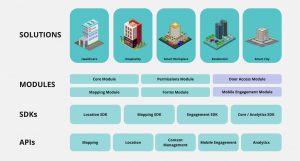At Phunware, we take a modular approach to the architecture of our product offerings.
There are many advantages to this approach. This allows our teams to work more effectively concurrently, to deliver & deploy enhancements more quickly, and to provide a wide-range of flexible options to our customers.
Our iOS and Android industry solutions are made up of modules, which sit on top of SDKs, which call various APIs. Let’s look into each of these in more detail.
Industry Solutions
Phunware provides tailored industry solutions for healthcare, hospitality, and various other sectors, offering personalized mobile apps designed to enhance customer satisfaction. From the moment they leave home to every step of their visit and back again, consumers expect a seamless experience.
Some of our largest customers, like Atlantis Bahamas, Gaylord Hotels, and Virginia Hospital Center, appreciate the rapid deployment and easy updates our solutions provide.
Our mobile app solutions are packed with features like dynamic content, indoor wayfinding, push notifications, analytics, and more—all designed to enhance user experiences.
Under the hood, these solutions are pre-integrated with several of our modules, described below.
Modules
You can think of modules as different components of a mobile app that have a specific feature set.
For example, our Mapping Module includes everything an app might need to deliver a robust wayfinding experience. The app simply needs to launch the Mapping Module and the user is now presented with a map displaying points of interest, search capabilities, and a discovery section.
Features such as static routing, GPS routing, and indoor BLE routing are supported. Users can select handicap accessible routing, enable voice directions, view turn-by-turn directions, or tap on points of interest to view detail pages.
Another popular module is our Mobile Engagement Module, which includes support for broadcast push notifications, geofence alerts, and beacon proximity messaging, all with a nice inbox to hold those messages and allow users to view promotions or re-trigger links.
Other modules include the Core Module, which handles content management, Forms Module, for form input, and Permissions Module, for handling app permissions such as location, bluetooth, or push notifications.
SDKs
But what if a customer wants the capabilities we offer, but prefers to develop their own UI and UX? That’s where SDKs come in. Our native iOS and Android SDKs act as true Software Development Kits. Third party developers can integrate our Mapping & Location SDK, Analytics SDK, or Mobile Engagement SDK and create whatever UI/UX they can imagine. We provide sample code, but it’s up to the developers to decide the look and feel.
APIs
Just about every app will need to connect to a web service to perform actions such as downloading content, registering for push notifications, or sending analytics.
Our solutions are no different. They are powered by our RESTful APIs for Mapping, Location, Content Management, Mobile Engagement, and Analytics.
The same is true for our web portal. When a customer updates their map, changes a piece of content, sets up a push notification campaign, or views how many app launches they received, they are using the same APIs that our SDKs use to deliver those experiences to end users.
Advantages
Now that we’ve covered our modular approach to architecture, it’s time to discuss the advantages.
The first is that this approach allows our developers to work on different components of our solutions without stepping on each other’s toes. For example, each module is in its own code repository so the developer working on the Mapping Module isn’t going to create merge conflicts for the developer working on the Mobile Engagement Module. It also allows developers to become specialists focusing on specific feature sets.
The second advantage is that this approach allows us to roll out changes quickly. For example, let’s say we wanted to add a new feature to our map. It wouldn’t make sense to make this change in every app codebase. Instead we implement it in the Mapping Module and release a new version. Each app, whether it’s a Phunware-developed Industry Solution app or a third-party developed custom app, can simply update to the latest version of the Mapping Module to receive the changes. This is as simple as updating the version number in a dependency management configuration file and rebuilding.
Finally, another major advantage to this approach is that we are able to offer a wide range of options for our customers. For the customers who want a complete solution, our Industry Solutions contain everything pre-integrated and ready to submit to the store. For customers who have an existing app, a better option might be to license individual modules. For example, a customer can add wayfinding capabilities to their app with a drop-in Mapping Module that can be integrated in as little as a day. For the customer who just wants the wayfinding capabilities but would prefer to design their own UI and UX, the Mapping & Location SDK is ideal for that. And for those who want maximum control, our APIs are always available.
At Phunware, we see ourselves as more than just a technology provider—we’re your partner in success. Think of us as your concierge in unifying your customers’ journey. Whether you need the complete solution or just the key components to build it yourself, we’re here to support you every step of the way. From design and implementation to integration, launch, adoption, and ongoing support, we ensure a seamless experience that lasts for years to come
As always, feel free to reach out! Contact us and our team of experts will guide you through Phunware’s mobile solution offerings, showing you how they can be tailored to meet your unique needs.








